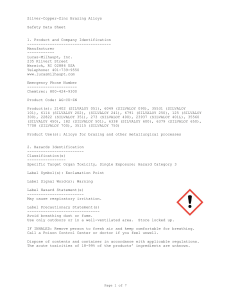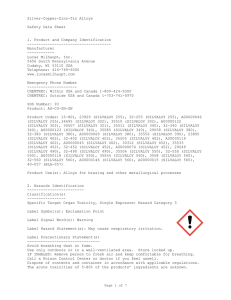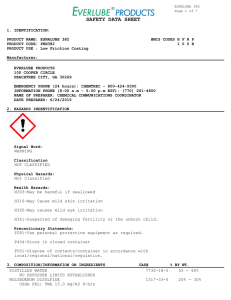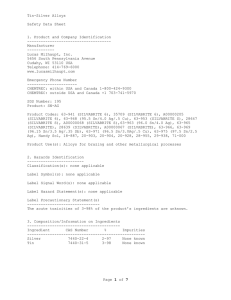ATC Air-Tool-Conditioner fabulous blaster
advertisement
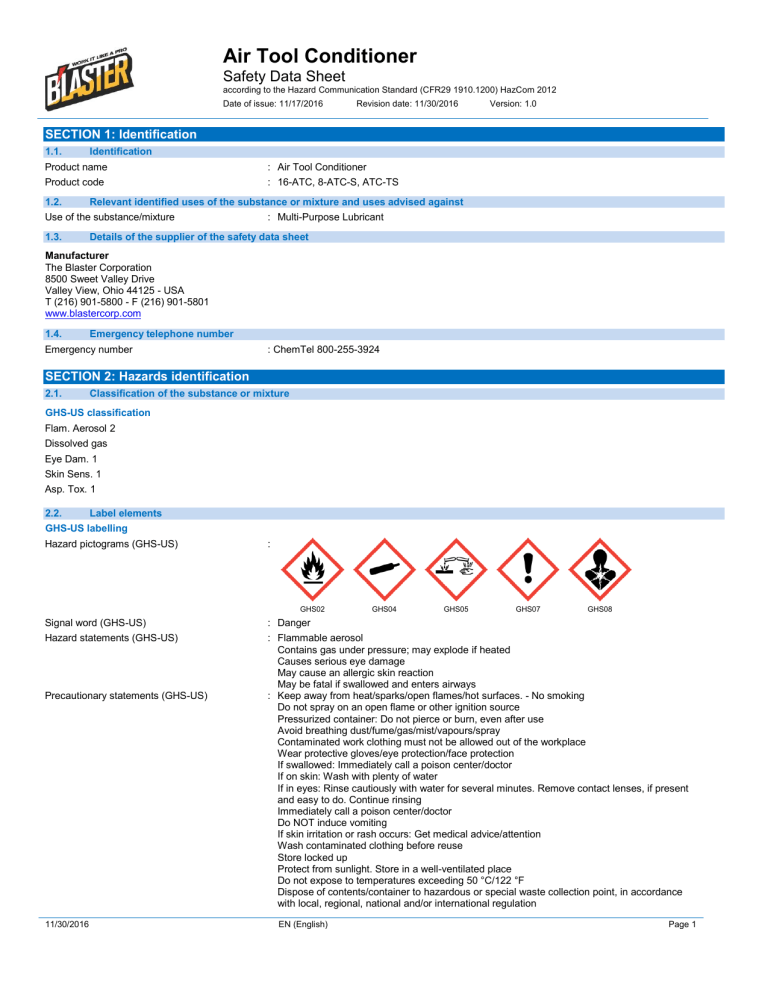
Air Tool Conditioner Safety Data Sheet according to the Hazard Communication Standard (CFR29 1910.1200) HazCom 2012 Date of issue: 11/17/2016 Revision date: 11/30/2016 Version: 1.0 SECTION 1: Identification 1.1. Identification Product name : Air Tool Conditioner Product code : 16-ATC, 8-ATC-S, ATC-TS 1.2. Relevant identified uses of the substance or mixture and uses advised against Use of the substance/mixture 1.3. : Multi-Purpose Lubricant Details of the supplier of the safety data sheet Manufacturer The Blaster Corporation 8500 Sweet Valley Drive Valley View, Ohio 44125 - USA T (216) 901-5800 - F (216) 901-5801 www.blastercorp.com 1.4. Emergency telephone number Emergency number : ChemTel 800-255-3924 SECTION 2: Hazards identification 2.1. Classification of the substance or mixture GHS-US classification Flam. Aerosol 2 Dissolved gas Eye Dam. 1 Skin Sens. 1 Asp. Tox. 1 2.2. Label elements GHS-US labelling Hazard pictograms (GHS-US) : Signal word (GHS-US) : Danger Hazard statements (GHS-US) : Flammable aerosol Contains gas under pressure; may explode if heated Causes serious eye damage May cause an allergic skin reaction May be fatal if swallowed and enters airways : Keep away from heat/sparks/open flames/hot surfaces. - No smoking Do not spray on an open flame or other ignition source Pressurized container: Do not pierce or burn, even after use Avoid breathing dust/fume/gas/mist/vapours/spray Contaminated work clothing must not be allowed out of the workplace Wear protective gloves/eye protection/face protection If swallowed: Immediately call a poison center/doctor If on skin: Wash with plenty of water If in eyes: Rinse cautiously with water for several minutes. Remove contact lenses, if present and easy to do. Continue rinsing Immediately call a poison center/doctor Do NOT induce vomiting If skin irritation or rash occurs: Get medical advice/attention Wash contaminated clothing before reuse Store locked up Protect from sunlight. Store in a well-ventilated place Do not expose to temperatures exceeding 50 °C/122 °F Dispose of contents/container to hazardous or special waste collection point, in accordance with local, regional, national and/or international regulation GHS02 Precautionary statements (GHS-US) 11/30/2016 EN (English) GHS04 GHS05 GHS07 GHS08 Page 1 Air Tool Conditioner Safety Data Sheet according to the Hazard Communication Standard (CFR29 1910.1200) HazCom 2012 2.3. Other hazards No additional information available 2.4. Unknown acute toxicity (GHS US) Not applicable SECTION 3: Composition/information on ingredients 3.1. Substances Not applicable 3.2. Mixtures Name Product identifier % Distillates, petroleum, hydrotreated heavy naphthenic (CAS No) 64742-52-5 50 - 60 Petroleum distillates, hydrotreated light (CAS No) 64742-47-8 20 - 30 Isopropyl alcohol (CAS No) 67-63-0 10 - 20 Phosphorodithioic acid, O,O-di-C1-14-alkyl esters, zinc salts (CAS No) 68649-42-3 1-5 Alcohols, C6-10, ethoxylated propoxylated (CAS No) 68987-81-5 1-5 Carbon dioxide (CAS No) 124-38-9 1-4 1-Naphthalenamine, N-phenyl- (CAS No) 90-30-2 0.1 - 1 (Note L) *Chemical name, CAS number and/or exact concentration have been withheld as a trade secret Note L : The classification as a carcinogen need not apply if it can be shown that the substance contains less than 3 % DMSO extract as measured by IP 346 ‘Determination of polycyclic aromatics in unused lubricating base oils and asphaltene free petroleum fractions — Dimethyl sulphoxide extraction refractive index method’, Institute of Petroleum, London. This note applies only to certain complex oil-derived substances in Part 3 SECTION 4: First aid measures 4.1. Description of first aid measures First-aid measures after inhalation : If breathing is difficult, remove victim to fresh air and keep at rest in a position comfortable for breathing. Call a POISON CENTER or doctor/physician if you feel unwell. First-aid measures after skin contact : In case of contact, immediately flush skin with plenty of water. Remove contaminated clothing and shoes. Wash clothing before reuse. Call a physician if irritation develops and persists. First-aid measures after eye contact : In case of contact, immediately flush eyes with plenty of water for at least 15 minutes. If easy to do, remove contact lenses, if worn. Get medical attention immediately. First-aid measures after ingestion : IF SWALLOWED: Immediately call a POISON CENTER or doctor/physician. Do NOT induce vomiting. 4.2. Most important symptoms and effects, both acute and delayed Symptoms/injuries after inhalation : May cause respiratory irritation. Symptoms/injuries after skin contact : May cause skin irritation. Symptoms may include redness, drying, defatting and cracking of the skin. May cause an allergic skin reaction. Symptoms/injuries after eye contact : Causes serious eye damage. Symptoms may include discomfort or pain, excess blinking and tear production, with marked redness and swelling of the conjunctiva. May cause burns. Symptoms/injuries after ingestion : May be fatal if swallowed and enters airways. This product may be aspirated into the lungs and cause chemical pneumonitis. May cause stomach distress, nausea or vomiting. 4.3. Indication of any immediate medical attention and special treatment needed Symptoms may not appear immediately. In case of accident or if you feel unwell, seek medical advice immediately (show the label or SDS where possible). SECTION 5: Firefighting measures 5.1. Extinguishing media Suitable extinguishing media : Carbon dioxide, dry chemical, halons, foam. Unsuitable extinguishing media : Do not use water jet. 5.2. Special hazards arising from the substance or mixture Fire hazard : Flammable aerosol. Products of combustion may include, and are not limited to: oxides of carbon and oxides of nitrogen. Explosion hazard : Heat may build pressure, rupturing closed containers, spreading fire and increasing risk of burns and injuries. Reactivity : No dangerous reaction known under conditions of normal use. 11/30/2016 EN (English) 2/8 Air Tool Conditioner Safety Data Sheet according to the Hazard Communication Standard (CFR29 1910.1200) HazCom 2012 5.3. Advice for firefighters Firefighting instructions : DO NOT fight fire when fire reaches explosives. Evacuate area. Protection during firefighting : Keep upwind of fire. Wear full fire fighting turn-out gear (full Bunker gear) and respiratory protection (SCBA). Vapors may be heavier than air and may travel along the ground to a distant ignition source and flash back. Use water spray to keep fire-exposed containers cool. SECTION 6: Accidental release measures 6.1. Personal precautions, protective equipment and emergency procedures General measures 6.1.1. : Use personal protection recommended in Section 8. Isolate the hazard area and deny entry to unnecessary and unprotected personnel. Isolate from fire, if possible, without unnecessary risk. Remove ignition sources. Use special care to avoid static electric charges. For non-emergency personnel No additional information available 6.1.2. For emergency responders No additional information available 6.2. Environmental precautions Avoid release to the environment. 6.3. Methods and material for containment and cleaning up For containment : Contain and/or absorb spill with inert material (e.g. sand, vermiculite), then place in a suitable container. Do not flush to sewer or allow to enter waterways. Use appropriate Personal Protective Equipment (PPE). Methods for cleaning up : Scoop up material and place in a disposal container. Provide ventilation. 6.4. Reference to other sections See section 8 for further information on protective clothing and equipment and section 13 for advice on waste disposal. SECTION 7: Handling and storage 7.1. Precautions for safe handling Additional hazards when processed : Hazardous waste due to potential risk of explosion. Pressurized container: Do not pierce or burn, even after use. Precautions for safe handling : Do not spray on an open flame or other ignition source. Keep away from sources of ignition No smoking. Use non-sparking tools. Use explosion-proof equipment. Take precautionary measures against static discharge. Avoid contact with skin and eyes. Do not swallow. Do not breathe gas, fumes, vapour or spray. When using do not eat, drink or smoke. Use only outdoors or in a well-ventilated area. Do not pierce or burn, even after use. Hygiene measures : Launder contaminated clothing before reuse. Wash hands before eating, drinking, or smoking. 7.2. Conditions for safe storage, including any incompatibilities Technical measures : Proper grounding procedures to avoid static electricity should be followed. Storage conditions : Keep locked up and out of reach of children. Do not expose to temperatures exceeding 50 °C/ 122 °F. Store away from direct sunlight or other heat sources. Keep in fireproof place. Storage area : Store in a well-ventilated place. SECTION 8: Exposure controls/personal protection 8.1. Control parameters Distillates, petroleum, hydrotreated heavy naphthenic (64742-52-5) ACGIH ACGIH TWA (mg/m³) 5 mg/m³ (oil mist) OSHA 5 mg/m³ (oil mist) OSHA PEL (TWA) (mg/m³) Petroleum distillates, hydrotreated light (64742-47-8) Not applicable Isopropyl alcohol (67-63-0) ACGIH ACGIH TWA (ppm) 200 ppm ACGIH ACGIH STEL (ppm) 400 ppm OSHA OSHA PEL (TWA) (mg/m³) 980 mg/m³ OSHA OSHA PEL (TWA) (ppm) 400 ppm 11/30/2016 EN (English) 3/8 Air Tool Conditioner Safety Data Sheet according to the Hazard Communication Standard (CFR29 1910.1200) HazCom 2012 Phosphorodithioic acid, O,O-di-C1-14-alkyl esters, zinc salts (68649-42-3) Not applicable Alcohols, C6-10, ethoxylated propoxylated (68987-81-5) Not applicable Carbon dioxide (124-38-9) ACGIH ACGIH TWA (ppm) 5000 ppm ACGIH ACGIH STEL (ppm) 30000 ppm OSHA OSHA PEL (TWA) (mg/m³) 9000 mg/m³ OSHA OSHA PEL (TWA) (ppm) 5000 ppm 1-Naphthalenamine, N-phenyl- (90-30-2) Not applicable 8.2. Exposure controls Appropriate engineering controls : Use ventilation adequate to keep exposures (airborne levels of dust, fume, vapor, etc.) below recommended exposure limits. Hand protection : Wear chemically resistant protective gloves. Eye protection : Wear approved eye protection (properly fitted dust- or splash-proof chemical safety goggles) and face protection (face shield). Skin and body protection : Wear suitable protective clothing. Respiratory protection : In case of insufficient ventilation, wear suitable respiratory equipment. Respirator selection must be based on known or anticipated exposure levels, the hazards of the product and the safe working limits of the selected respirator. Environmental exposure controls : Maintain levels below Community environmental protection thresholds. Other information : Do not eat, smoke or drink where material is handled, processed or stored. Wash hands carefully before eating or smoking. Handle according to established industrial hygiene and safety practices. SECTION 9: Physical and chemical properties 9.1. Information on basic physical and chemical properties Physical state : Liquid Appearance : Aerosol Colour : Red Odour : Alcohol Odour threshold : No data available pH : No data available Melting point : No data available Freezing point : No data available Boiling point : 82 °C (180 ⁰F) Flash point : 12 °C (54 ⁰F) Relative evaporation rate (butylacetate=1) : 2.9 (Isopropanol) Flammability (solid, gas) : Flammable aerosol. Vapour pressure : 33 mm Hg at 20 ⁰C (68 ⁰F) Relative vapour density at 20 °C : 2.1 (Isopropanol) Relative density : 0.86 at 20 ⁰C (68 ⁰F) Solubility : No data available Partition coefficient n-octanol/water : No data available Auto-ignition temperature : 399 °C (750 ⁰F) Isopropanol Decomposition temperature : No data available Viscosity, kinematic : No data available Viscosity, dynamic : No data available Explosive limits : Lower explosive limit (LEL): 2 vol % (Isopropanol) Upper explosive limit (UEL): 12 vol % (Isopropanol) 11/30/2016 EN (English) 4/8 Air Tool Conditioner Safety Data Sheet according to the Hazard Communication Standard (CFR29 1910.1200) HazCom 2012 Explosive properties : No data available Oxidising properties : No data available 9.2. Other information Heat of Combustion : 44.6 kJ/g Flame Projection : 0 inches Flashback : None SECTION 10: Stability and reactivity 10.1. Reactivity No dangerous reaction known under conditions of normal use. 10.2. Chemical stability Stable under normal storage conditions. Flammable aerosol. Contents under pressure. Container may explode if heated. Do not puncture. Do not burn. Extreme risk of explosion by shock, friction, fire or other sources of ignition. 10.3. Possibility of hazardous reactions No dangerous reaction known under conditions of normal use. 10.4. Conditions to avoid Sources of ignition. Heat. Incompatible materials. 10.5. Incompatible materials Strong oxidizing agents. 10.6. Hazardous decomposition products May include, and are not limited to: oxides of carbon and oxides of nitrogen. SECTION 11: Toxicological information 11.1. Information on toxicological effects Acute toxicity Air Tool Conditioner LD50 oral rat LD50 dermal rabbit LC50 inhalation rat : Not classified. > 2000 mg/kg (Calculated Acute Toxicity Estimate) > 2000 mg/kg (Calculated Acute Toxicity Estimate) > 5 mg/l/4h (Calculated Acute Toxicity Estimate) Petroleum distillates, hydrotreated light (64742-47-8) LD50 oral rat > 5000 mg/kg LD50 dermal rabbit > 2000 mg/kg LC50 inhalation rat > 5.2 mg/l/4h Isopropyl alcohol (67-63-0) LD50 oral rat LD50 dermal rabbit LC50 inhalation rat 1870 mg/kg 4059 mg/kg 72600 mg/m³ (Exposure time: 4 h) 1-Naphthalenamine, N-phenyl- (90-30-2) LD50 oral rat LD50 dermal rabbit 1625 mg/kg > 8000 mg/kg Skin corrosion/irritation : Not classified. Serious eye damage/irritation : Causes serious eye damage. Respiratory or skin sensitisation : May cause an allergic skin reaction. Germ cell mutagenicity : Not classified. Carcinogenicity : Not classified. Isopropyl alcohol (67-63-0) IARC group 3 - Not classifiable Reproductive toxicity : Not classified. Specific target organ toxicity (single exposure) : Not classified. 11/30/2016 EN (English) 5/8 Air Tool Conditioner Safety Data Sheet according to the Hazard Communication Standard (CFR29 1910.1200) HazCom 2012 Specific target organ toxicity (repeated exposure) : Not classified. Aspiration hazard : May be fatal if swallowed and enters airways. Symptoms/injuries after inhalation : May cause respiratory irritation. Symptoms/injuries after skin contact : Causes mild skin irritation. Symptoms may include redness, drying, defatting and cracking of the skin. May cause an allergic skin reaction. Symptoms/injuries after eye contact : Causes serious eye damage. Symptoms may include discomfort or pain, excess blinking and tear production, with marked redness and swelling of the conjunctiva. May cause burns. Symptoms/injuries after ingestion : May be fatal if swallowed and enters airways. This product may be aspirated into the lungs and cause chemical pneumonitis. May cause stomach distress, nausea or vomiting. Other information : Likely routes of exposure: ingestion, inhalation, skin and eye. SECTION 12: Ecological information 12.1. Toxicity Ecology - general : May cause long-term adverse effects in the aquatic environment. Distillates, petroleum, hydrotreated heavy naphthenic (64742-52-5) LC50 fish 1 > 5000 mg/l (Exposure time: 96 h - Species: Oncorhynchus mykiss) EC50 Daphnia 1 > 1000 mg/l (Exposure time: 48 h - Species: Daphnia magna) Petroleum distillates, hydrotreated light (64742-47-8) LC50 fish 1 45 mg/l (Exposure time: 96 h - Species: Pimephales promelas [flow-through]) LC50 fish 2 2.2 mg/l (Exposure time: 96 h - Species: Lepomis macrochirus [static]) Isopropyl alcohol (67-63-0) LC50 fish 1 EC50 Daphnia 1 LC50 fish 2 9640 mg/l (Exposure time: 96 h - Species: Pimephales promelas [flow-through]) 13299 mg/l (Exposure time: 48 h - Species: Daphnia magna) 11130 mg/l (Exposure time: 96 h - Species: Pimephales promelas [static]) Phosphorodithioic acid, O,O-di-C1-14-alkyl esters, zinc salts (68649-42-3) LC50 fish 1 1.0 - 5.0 mg/l (Exposure time: 96 h - Species: Pimephales promelas [static]) EC50 Daphnia 1 1 - 1.5 mg/l (Exposure time: 48 h - Species: Daphnia magna) LC50 fish 2 10.0 - 35.0 mg/l (Exposure time: 96 h - Species: Pimephales promelas [semi-static]) 12.2. Persistence and degradability Air Tool Conditioner Persistence and degradability 12.3. Not established. Bioaccumulative potential Air Tool Conditioner Bioaccumulative potential Not established. Petroleum distillates, hydrotreated light (64742-47-8) BCF fish 1 61 - 159 Isopropyl alcohol (67-63-0) Partition coefficient n-octanol/water 0.05 (at 25 °C) Carbon dioxide (124-38-9) BCF fish 1 (no bioaccumulation) 12.4. Mobility in soil No additional information available 12.5. Other adverse effects Effect on the global warming 11/30/2016 : No known effects from this product. EN (English) 6/8 Air Tool Conditioner Safety Data Sheet according to the Hazard Communication Standard (CFR29 1910.1200) HazCom 2012 SECTION 13: Disposal considerations 13.1. Waste treatment methods Waste disposal recommendations : This material must be disposed of in accordance with all local, state, provincial, and federal regulations. The generation of waste should be avoided or minimized wherever possible. Additional information : Flammable vapours may accumulate in the container. SECTION 14: Transport information Department of Transportation (DOT) In accordance with DOT UN-No.(DOT) : UN1950 Proper Shipping Name (DOT) : Aerosols Class (DOT) : 2.1 - Class 2.1 - Flammable gas 49 CFR 173.115 Hazard labels (DOT) : flammable, (each not exceeding 1 L capacity) SECTION 15: Regulatory information 15.1. US Federal regulations All components of this product are listed, or excluded from listing, on the United States Environmental Protection Agency Toxic Substances Control Act (TSCA) inventory. Isopropyl alcohol (67-63-0) Subject to reporting requirements of United States SARA Section 313 SARA Section 313 - Emission Reporting 1 % (only if manufactured by the strong acid process, no supplier notification) Polyethylene glycol (25322-68-3) EPA TSCA Regulatory Flag XU - XU - indicates a substance exempt from reporting under the Inventory Update Reporting Rule, i.e, Partial Updating of the TSCA Inventory Data Base Production and Site Reports (40 CFR 710(C)) Alcohols, C6-10, ethoxylated propoxylated (68987-81-5) EPA TSCA Regulatory Flag XU - XU - indicates a substance exempt from reporting under the Inventory Update Reporting Rule, i.e, Partial Updating of the TSCA Inventory Data Base Production and Site Reports (40 CFR 710(C)) 15.2. International regulations No additional information available 15.3. US State regulations California Proposition 65 - This product does not contain any substances known to the state of California to cause cancer, developmental and/or reproductive harm Isopropyl alcohol (67-63-0) U.S. - New Jersey - Right to Know Hazardous Substance List U.S. - Pennsylvania - RTK (Right to Know) - Environmental Hazard List U.S. - Pennsylvania - RTK (Right to Know) List Carbon dioxide (124-38-9) U.S. - New Jersey - Right to Know Hazardous Substance List U.S. - Pennsylvania - RTK (Right to Know) List SECTION 16: Other information Date of issue : 11/17/2016 Revision date : 11/30/2016 11/30/2016 EN (English) 7/8 Air Tool Conditioner Safety Data Sheet according to the Hazard Communication Standard (CFR29 1910.1200) HazCom 2012 Other information : None. Prepared by : Nexreg Compliance Inc. www.Nexreg.com SDS US (GHS HazCom 2012)_NEXREG_NEW Disclaimer: We believe the statements, technical information and recommendations contained herein are reliable, but they are given without warranty or guarantee of any kind. The information contained in this document applies to this specific material as supplied. It may not be valid for this material if it is used in combination with any other materials. It is the user’s responsibility to satisfy oneself as to the suitability and completeness of this information for the user’s own particular use. 11/30/2016 EN (English) 8/8
